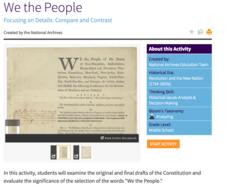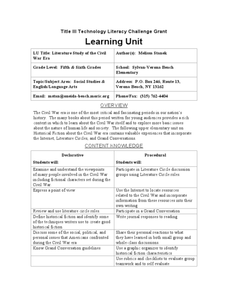Heritage Foundation
The Constitution, Federalism, and the States
The divide between federal and state government is responsible for much of tension that continues to this day, partly because of the US Constitution. The activities in the 14th instructional activity in a series of 20 are designed to...
Heritage Foundation
The Amendment Process and the Bill of Rights
Did you know that lawmakers have proposed more than 5,000 bills to amend the US Constitution in Congress? Your class learns intriguing facts about the process of choosing amendments. A variety of activities including before and after...
Heritage Foundation
Substantive Amendments: Amendments I and II
The First and Second Amendments remain some of the most famous, even to this day. Learners read about several clauses from the US Constitution through a variety of captivating activities including before and after reading, group work,...
Montana State University
Ice in Action
Make your own bite-size glacier! A resource teaches about the formation and melting of ice. Activities include videos, a hands-on activity where your pupils build glaciers, and a photographic analysis to teach individuals the chilling...
Heritage Foundation
Congress's Territorial Powers, Implied Powers, Citizenship, and the Bureaucracy
An informative resource gives scholars a look into why the US Constitution placed certain federal powers over that of the state. A variety of activities about constitutional clauses helps to create meaningful learning.
Curated OER
The Gettysburg Address by Abraham Lincoln
"The Gettysburg Address" is the basis of a series of activities that not only model for learners how to conduct a close reading of a text, but also how a close reading can help them comprehend a difficult text. The detailed, step-by-step...
EduGAINs
Introduction to the Great Depression—Canadian and World Studies
Ah, the classic business cycle model: recession, depression, recovery, prosperity. And then there was the Great Depression. Groups investigate the economic conditions that led to and social movements of the 1920s that great out of the...
Curated OER
Taxes in U.S. History: The Social Security Act of 1935
Learners explain the history of the Social Security Act and the FICA tax. They describe what Social Security is and whom it is intended to help. They explain the purpose of the FICA tax.
US National Archives
We the People Focusing on Details: Compare and Contrast
Even the most inspiring documents in American history had to go through a few drafts before they were ready for publication. Reinforce the importance of the writing process, as well as the collaborative nature of democracy, with an...
Committee for Children
Create a Positive Classroom Climate and Help Stop Bullying
Encourage kindness and respect with an activity that challenges scholars to create a poster that details three ways to exhibit the desired character traits.
Curated OER
Nevada Native Seasonal Activities
Here is an excellent series of lessons on the Paiute Indians of Nevada. In them, learners see that the four Native Tribes of Nevada respected and depended on their natural environment. They had four distinct ways of life according to the...
Story Corps
The Power of Active Listening
Listen up! The game of Telephone launches a study of active listening. Class members watch a short video that demonstrates active listening and tips on practicing active listening. Pairs then interview each other and practice their...
Curated OER
Physical Challenge Activity Cards and Parent Letter
In this study of physical challenges and inventions worksheet, students take a letter home to their families explaining that they will be studying the affects of physical challenges and inventions that aid people who live with them. They...
Australian Human Rights Commission
Introduction to the Universal Declaration of Human Rights
Human rights became a global focus after decades of war, recovery from war, and uncountable war crimes committed throughout. Social studies class members discuss the Universal Declaration of Human Rights before completing an interactive...
Historica-Dominion Institute
Artifact Creation Activity
Creating an artifact that is representative of a specific time period provides an opportunity for amateur historians to understand the importance of primary sources. This resource describes the process for students to explore original or...
Curated OER
Literature Study of the Civil War Era
Learn more about the Civil War. Young scholars will choose a novel based on the Civil War to learn more about the viewpoints of that time period. They will then discuss the roles of the members of a Literature Circle and then participate...
Curated OER
Across the United States- Home Learning Activity
In this home-school United States map learning exercise, students work with a family partner as they study a map of the United States. They talk about the states they have visited, play a game by giving each other clues about states, and...
Curated OER
An Inspiring Scene
In Guatemala, around AD 600-900, a vase was created. This vase is the inspiration for a lesson that incorporates expressive language skills, writing skills, and social studies. Children analyze the images on the vase and then choose one...
Museum of Tolerance
Family Tree Activity
Discover the family histories that make the classroom with a family tree activity. Scholars locate information about their family, construct a family tree, and work together to tally where family members are born.
Polk Bros Foundation
Chicago: Choices and Changes
Chicago, a city that is ever changing. A thought-provoking lesson, geared toward third-grade social studies, explains how the city of Chicago has changed over time. It discusses important leaders to the founding of the city, like Daniel...
DocsTeach
Where Was the New Deal?
Young historians delve into the origin of federal social programs to understand the impact of the New Deal. An informative activity explores some of the New Deal programs, such as the Civilian Conservation Corp, using historical...
C-SPAN
Electoral College Pros/Cons and Alternatives
If every vote counts, why do we need the electoral college? Middle and high schoolers study the Constitutional precedent of the electoral college, as well as its place in historical and modern elections, with an engaging social studies...
Lesson Snips
Lessons from the Holocaust
Connect global examples of attempted genocide with a well-designed social studies instructional activity. It includes an excellent informational text with background information on the Holocaust, as well as worksheets, book report...
Center for Civic Education
What Basic Ideas About Government Are Included in the Preamble to the Constitution?
Young historians explore the meaning of the Preamble to the US Constitution in this upper-elementary social studies activity. Working with partners or in small groups, children discuss the purpose of government before reading and...

























